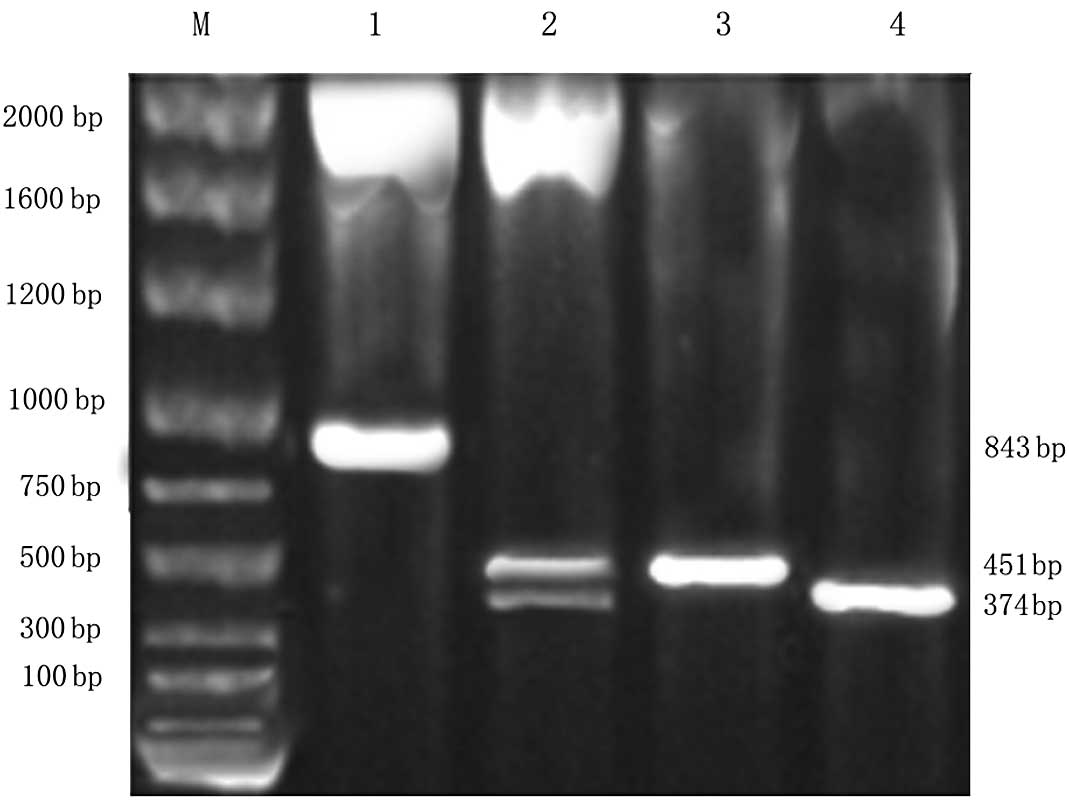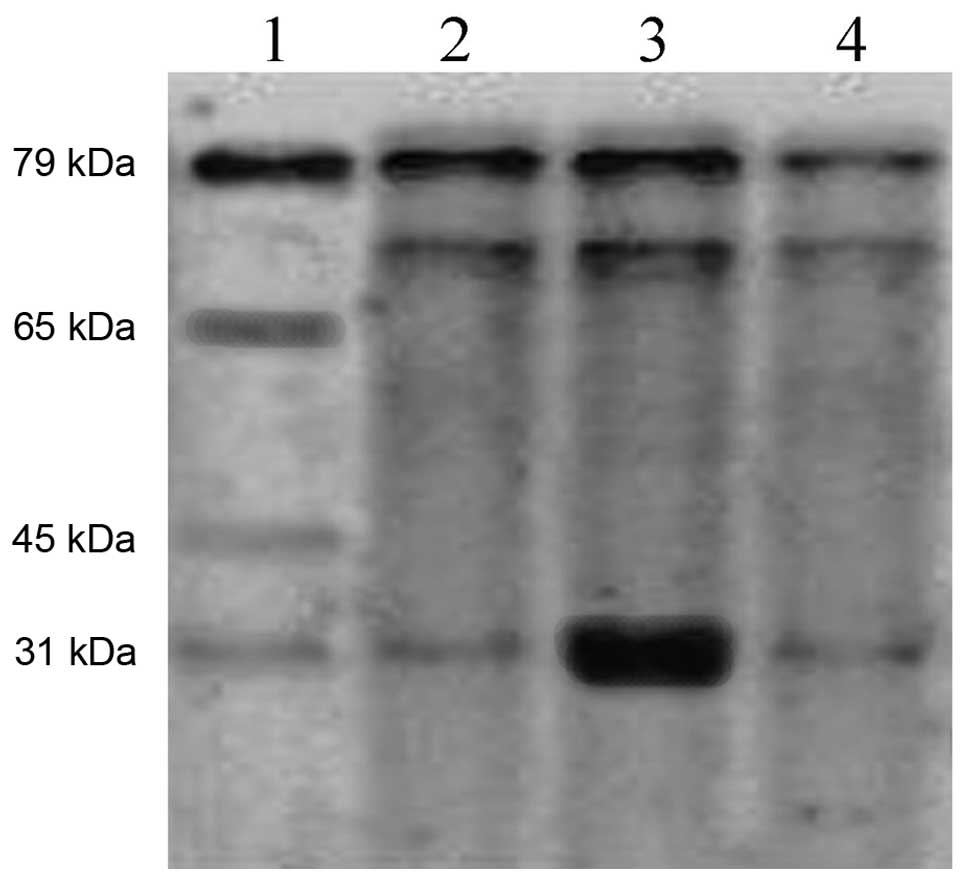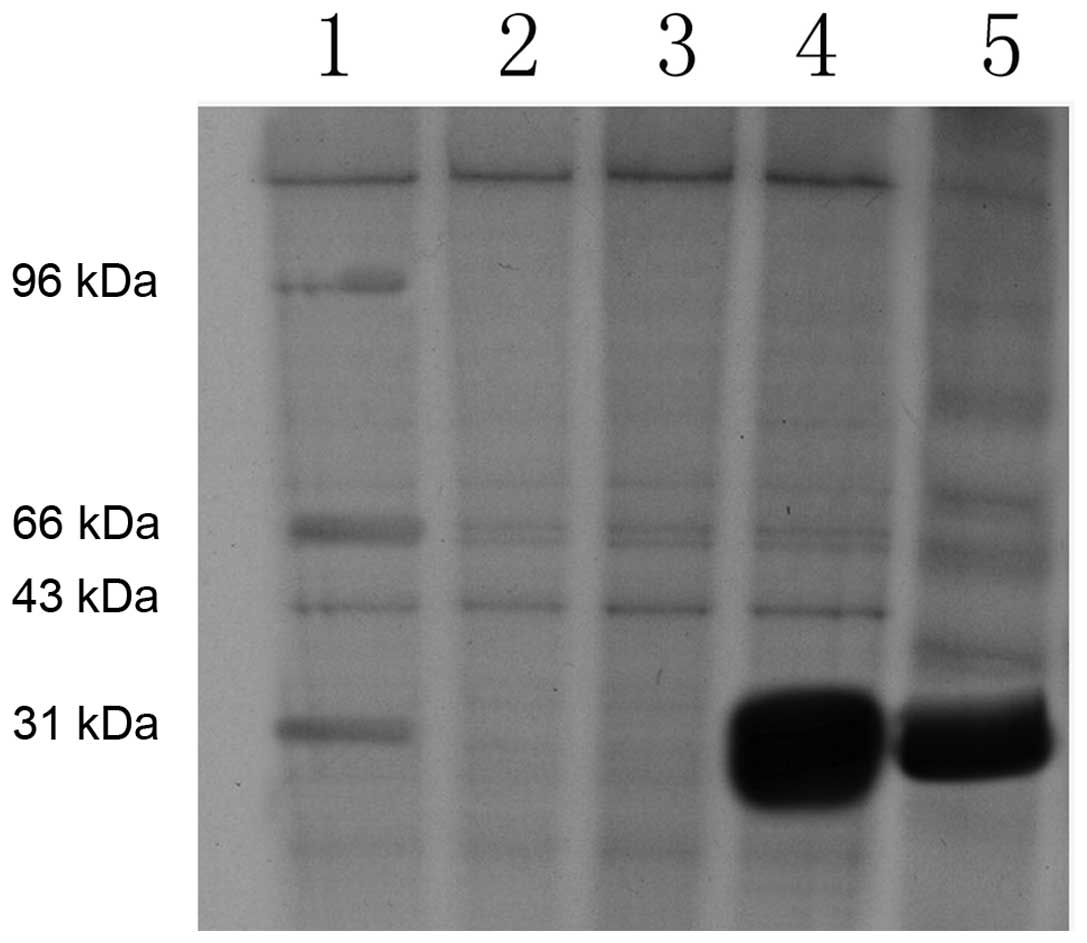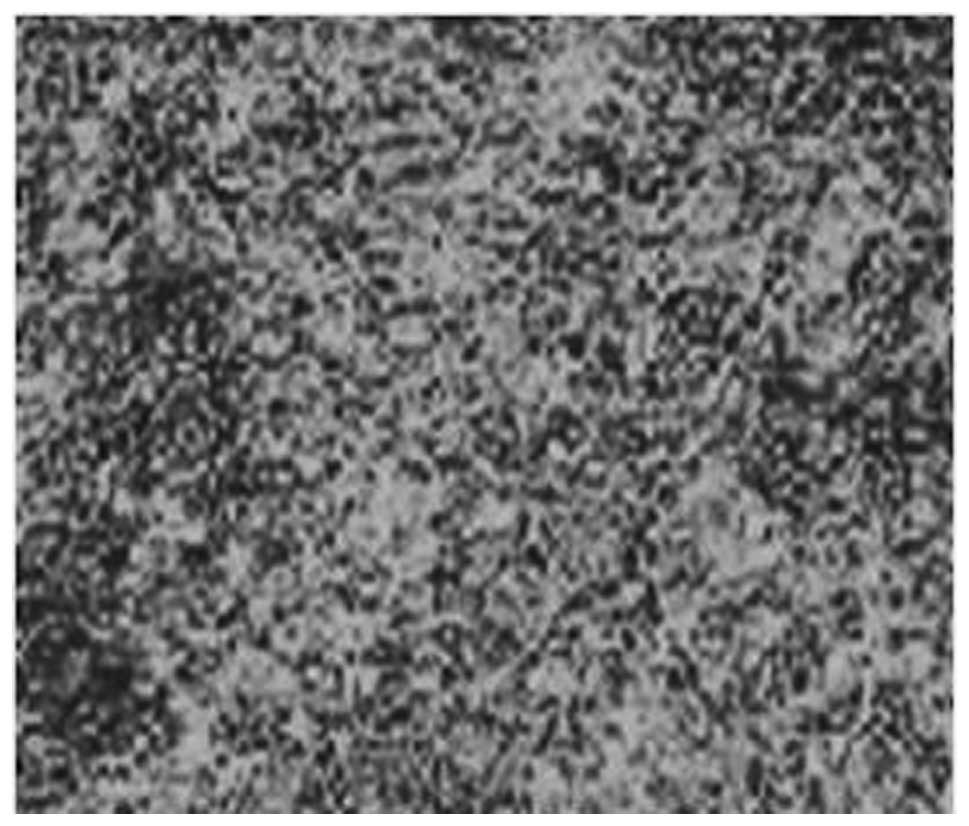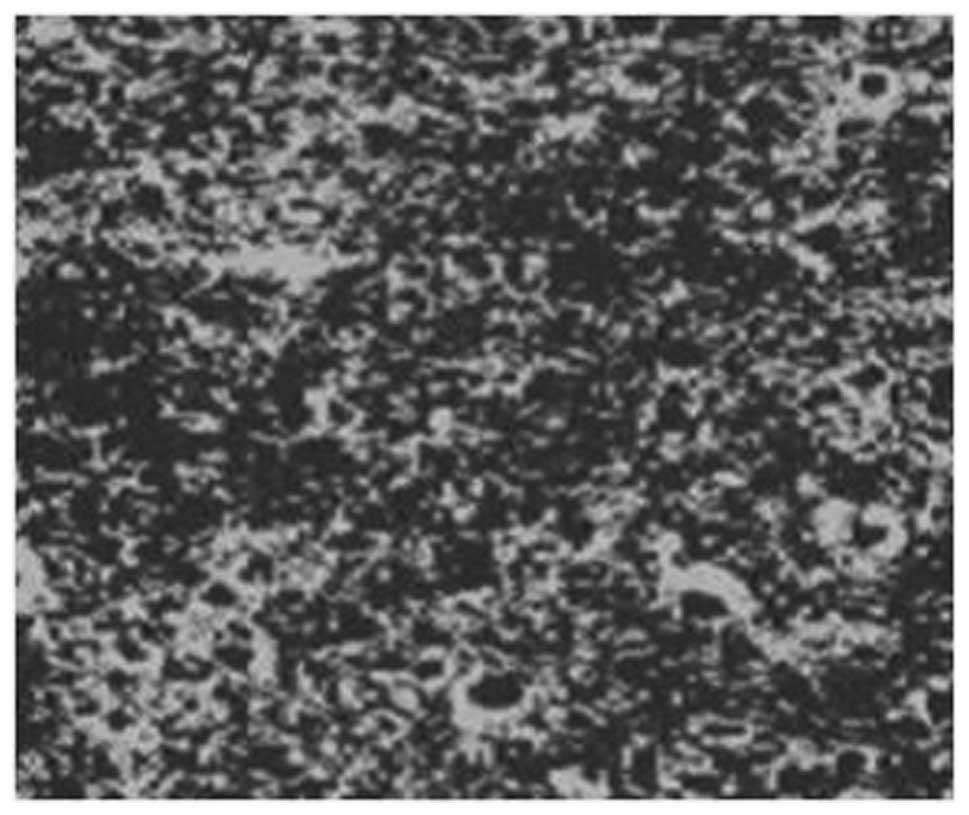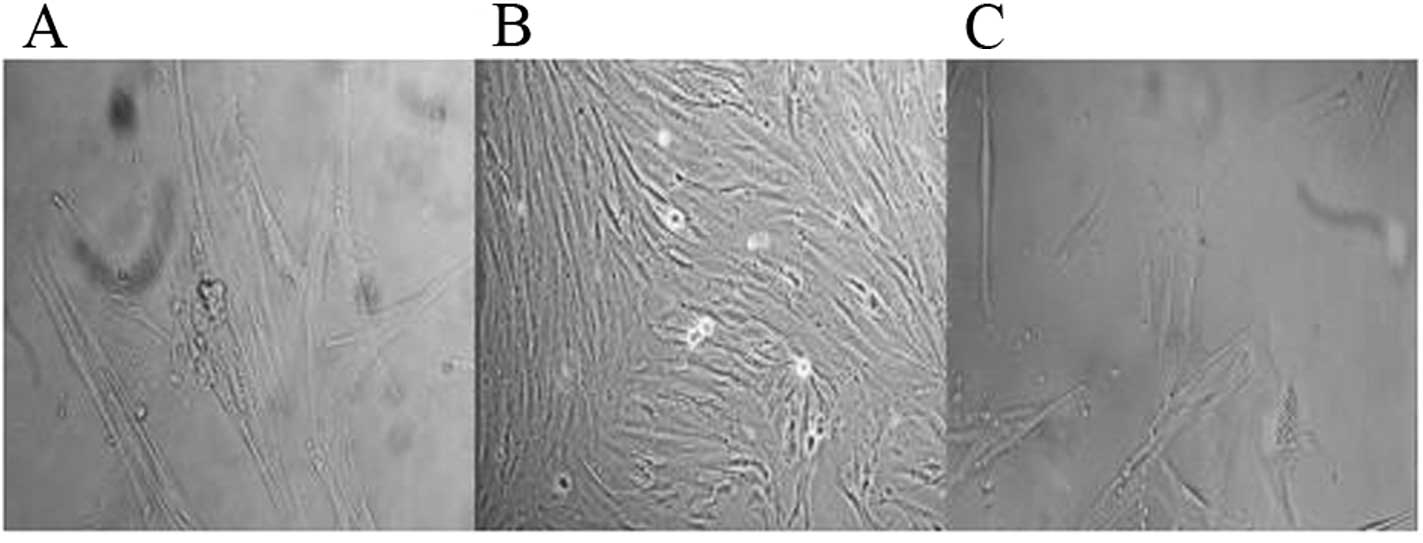Effect of recombinant adeno-associated BMP‑4/7 fusion gene on the biology of BMSCs
- Authors:
- Published online on: September 20, 2012 https://doi.org/10.3892/mmr.2012.1090
- Pages: 1413-1417
Abstract
Introduction
Studies on the molecular biological mechanisms of bone healing have made several breakthroughs in recent years (1,2), and it has been confirmed that the bone morphogenetic proteins (BMPs) generated during the bone healing process are capable of inducing bone regeneration and promoting bone healing. At present, the BMP family has been found to have over 20 members, and they can induce the proliferation and differentiation of undifferentiated mesenchymal cells to form cartilage and new bones; therefore, the research in this field has great clinical application potential and broad prospects for further study (1–4). BMPs are mostly homodimers in vivo, but at the same time, small amounts of heterodimers have also been identified. Several studies (5–8) have shown that the BMP heterodimer has higher activity than the homodimer, but the mechanism responsible for this requires further study.
The cDNA for the mature peptides of BMP-4 and BMP-7 was cloned in tissues and cells, respectively, in this experiment, and the encoding mature peptide genes of the two were connected to produce the BMP-4/7 fusion gene. The AAV-BMP-4/7 recombinant adeno-associated virus (AAV) was prepared and the expression of the fusion gene was detected, as well as its effect on cell differentiation and proliferation. In addition, the activity of alkaline phosphatase (ALP) and osteocalcin (OC) was observed following transfection and cultivation of the bone marrow stromal cells (BMSCs).
Materials and methods
Rabbit bone marrow stromal cell (BMSC) culture
Thirteen healthy male New Zealand rabbits were provided by the Central Laboratory of the First Hospital of Harbin Medical University. The rabbits weighed approximately 2.0 kg and were 2.5 months old. Rabbit BMSCs were isolated and cultured using the bone marrow method for primary culture. After the cells reached confluence into a monolayer for digestion and passage, the third generation cells that exhibited good growth were collected for use in the experiment. This study was conducted with approval from the Ethics Committee of the First Hospital of Harbin Medical University, China.
Plasmid construction
The primers of the hBMP-7 and hBMP-7 genes were designed according to the mature peptide sequences. The EcoRI and BamHI sites were introduced upstream and downstream of the hBMP4 gene. The BamHI and PstI sites were inserted upstream and downstream of the hBMP-7 gene. The cDNA sequences of BMP-4 and hBMP-7 were amplified through one-step reverse transcriptase polymerase chain reaction (RT-PCR) from the placental tissue, and were cloned into the pGEM-T vector to produce the recombinant plasmids pGEM-BMP-4 and pGEM-BMP-7. The two plasmids were digested with EcoRI/BamHI and BamHI/PstI enzymes, and then ligated with T4 ligase at 16°C overnight. This was followed by transformation into Escherichia coli DH5α to screen the positive clones, which were identified by EcoRI/BamHI and BamHI/PstI double enzyme digestion, 1.5% agarose gel electrophoresis and sequencing.
The BMP-4 and BMP-7 gene fragments were ligated to produce the BMP-4/7 fusion gene, and were then cloned into the pGEM plasmid identified by sequencing. The BMP-4/7 fusion gene was cleaved from pGEM-BMP-4/7, the recombination was completed in E. coli, and recombinant adeno-associated plasmids were produced in 293 cells. To conduct EcoRI, BamHI and PstI enzyme digestion identification and analysis, the AAV-BMP-4/7 plasmid was transformed into DH5α. A large number of AAV plasmids were extracted, Lipofectamine 2000 was used to transfect the 293 cells according to the manufacturer’s instructions, and G418 selection and culture were conducted to obtain a drug-resistant cloned cell line.
Expression of fusion gene and purification
The AAV-BMP-4/7 plasmid was transformed into E. coli DH5α cells and cultured at 37°C. When the OD reached 0.6, IPTG was added until the ultimate volume concentration became 0.4 mmol/l, and the temperature was increased to 42°C to induce the expression of recombinant protein for 4–6 h. Protein purification was performed using a conventional method. SDS-PAGE electrophoresis was carried out for the protein in the supernatant and the inclusion body to detect the protein expression.
ELISA
A large number of AAV plasmids were extracted, and liposome Lipofectamine 2000 was used to transfect 293 cells according to the manufacturer’s instructions. The cells were then screened under G418 selection and cultured until the drug-resistant cell colonies appeared. Rabbit BMSCs were seeded in 24-well plates at 1×105/well, with each group containing 6 duplicate holes, and virus solution was added with different doses of 10, 50, 100 and 200 μl, respectively, and the supernatant was removed after 24 h for detection with the human BMP ELISA kit.
Cell morphology
After digestion of 105 cells in a 24-well plate with 0.25% trypsinase, third generation cells in a good state were selected and inoculated. The cells were then cultured until 70% confluence and inoculated with the virus. Four groups with different multiplicity of infection (MOI) values of AAV transfection, namely 5×104, 1×105, 5×105 and 1×106 vg/cell, respectively, were selected for the experiment. Each group contained six wells. Based on their MOI values, the required amount of virus and serum Dulbecco’s modified Eagle’s medium (DMEM) were added into each well. The virus solution was aspirated 2 h after transfection and added to ordinary DMEM for conventional culture. The cell changes were observed every 24 h following transfection.
Osteogenic activity
The cells were cultured for 7 and 14 days after transfection with AAV-BMP-4/7 for 2 h (experimental group). Morphological cellular changes and osteogenic differentiation were observed with an inverted phase contrast microscope. AAV-EGFP was taken as the control group (six samples each). Approximately 7 and 14 days after transfection, the supernatant of the two groups of cells were collected. According to the instructions of the alkaline phosphatase (ALP) assay kit, colorimetric determination (520 mm, 1 cm light path colorimetry) was conducted, and the ALP content was measured in the supernatants. The supernatants of the two groups of cells were collected at 7 and 14 days after transfection. The osteocalcin (OC) values were tested according to the kit instructions. Approximately 100 μl of the cell culture medium was collected, then mixed with 100 μl 125I-labeled OC antibodies, and stored at 4°C for 24 h. Separated agent from the kit was then added and mixed, which was placed at room temperature and centrifuged at 4°C. The radiation dose of the detected precipitation in the supernatants was discarded, and then the average OC content of each group was calculated (repeated six times).
Statistical analysis
Data were analyzed using the statistical package SPSS 11.5, and the data were presented as the means ± SD, comparing the concentration of protein expression in different doses of virus solution using analysis of variance. P<0.05 was considered to indicate a statistically significant difference.
Results
Plasmid construction
The pGEM-BMP-4 and pGEM-BMP-7 plasmids were extracted and identified through agarose gel electrophoresis and PCR primer expansion identification. Two bright bands of 374 and 451 bp were observed. The sequencing result was consistent with the report in GenBank and the sizes of the mature peptide gene sequences of BMP-4 and BMP-7.
AAV-BMP-4/7 was successfully obtained. A band of 826 bp was observed through double enzyme digestion. Two bright bands of approximately 374 and 451 bp on the agarose gel electrophoresis appeared following EcoRI, BamHI and PstI identification and PCR primer expansion (Fig. 1), which indicated that the fusion gene of BMP-4 and BMP-7 was successfully obtained. The AAV plasmid carrying the BMP-4/7 fusion gene was generated following recombination.
Expression of fusion gene and purification
AAV-BMP-4/7 recombinant plasmid was transformed into E. coli for induced expression, and after conducting SDS-PAGE electrophoresis, the protein band could be observed at 29–30 kDa (Fig. 2). The bacteria, supernatants and precipitates were dissolved and purified, and the majority of proteins were determined to precipitate in the inclusion body by SDS-PAGE electrophoresis (Fig. 3).
The expression of BMP-4/7 increased significantly after cells were transfected with 10, 50, 100 and 200 μl of virus solution, with the expression concentration being 5.614±0.167 ml, 13.698±0.523, 17.214±0.312 and 19.003±0.276 μg/ml respectively, and the difference had statistical significance (F=1937.276, P<0.001).
Cell morphology
We removed the cells from the AAV-BMP-4/7-transfected group and the AAV-EGFP-transfected group, and after transfection for 7 and 14 days, observed them using an inverted phase contrast microscope. It was observed that after the AAV-BMP-4/7 group was transfected for 7 days, the cell morphology changed significantly, and notably, the distribution of the cells was uneven, showing partial intensive and local porosity, with the cells being polygonal, while it was observed under a high-power field that there were brown particles in the cytoplasm, showing a significant osteogenic change. It was observed after 14 days that the cells showed multiple-layer growth, and the brown particles in the cytoplasm were more evident, which indicates that the cell calcium nodule was formed. Van Gieson (VG) staining dyed the nodules black, and there may be bone cells attached around the nodules (Figs. 4 and 5). The untransfected group only showed cell contraction and irregular margins, but no specific changes in osteogenic cell differentiation (Fig. 6).
ALP content determination
Two groups of cells were selected for transfection. The cell supernatants were removed after 7 and 14 h to detect the ALP concentration. The content of the AAV-BMP-4/7 group was 67.2±8.4 and 106.5±12.1 Kim units, whereas the contents of the AAV-EGFP group were 10.1±2.7 and 23.6±4.8 Kim units. The difference between the two groups was statistically significant (t=896.88, P<0.001).
OC content determination
Two groups of cells were selected for transfection. We removed the cell supernatants after 7 and 14 h to calculate the OC contents. The concentrations of the AAV-BMP-4/7 group were 0.289±0.014 and 0.363±0.076 ng/ml, whereas those of the untransfected group were 0.011±0.007 and 0.017±0.010 ng/ml. The difference between the two groups was statistically significant (t=543.24, P<0.01).
Discussion
At present, bone tissue regeneration is the first of a variety of studies of tissue regeneration, and its mechanism is more clear (9–12). The basic concepts of bone regeneration, such as bone induction, bone conduction, bone generation and bone reconstruction, have been widely accepted by many researchers who have reached a consensus. The aim of constructing tissue engineered bones in vivo is to enable bone regeneration at bone defect sites, and for the tissue engineered bones to gradually develop similar structures to surrounding bones under stress stimulation and to integrate with them, so as to ultimately restore the normal functions of bone defect sites.
BMSCs belong to the osteogenic stem cells and have the potential to transform into various cell lines. They can achieve cross-system differentiation under certain external environment conditions and stimulating factors, and as they have the characteristics of being convenient to obtain and easy to culture, they are a good source of seed cells for tissue engineering (5,13,14). BMSCs consist of two types of osteogenic precursor cells: i) Oriented osteogenic precursor cells (OOPCs) that can perform oriented differentiation into osteogenic cells without induction; ii) induced osteogenic precursor cells (IOPCs) that can only perform oriented differentiation into osteogenic cells with induction by specific factors. When cultured in osteogenic culture solution, BMSCs transform into osteogenic cells and have active osteogenic ability.
The bone induction abilities of BMP-2, BMP-4 and BMP-7 are the strongest of more than 20 types of BMPs that have been found, particularly BMP-4. Recent studies confirm that the role of recombinant human BMP-4 in promoting spinal fusion is stronger than recombinant human BMP-2, and its required dose is only one tenth of the recombinant BMP-2, with the osteogenic volume being positively correlated with the dose (15,16). As BMP heterodimers have higher activity than homodimers in vivo, the mechanism of action remains unclear. In order to investigate the relationship between the structure and function of BMPs, this experiment selected BMP-4 and BMP-7 as target genes, and used DNA recombinant technology to connect BMP-4 and BMP-7, so as to successfully clone the fusion gene into the shutter vector and then obtain the recombinant AAV-BMP-4/7 plasmid, which successfully and stably expressed BMP-4/7 in 293 cells. It was detected that the recombinant gene is expressed in the cytoplasm of E. coli and the inclusion body, and after division and purification identification, high levels of target proteins were detected in the inclusion body. According to these results, the fusion gene of the mature peptide BMP-4/7 is expressed in E. coli through the AAV vector, and some of the expression products exist in the supernatant, while most exist in the form of an inclusion body. This lays the experimental foundation for further study on whether the BMP-4/7 heterodimer is capable of promoting the osteogenic effect of BMSCs.
Adeno-associated virus (AAV) (17–20) belongs to the parvoviridae, and the following features draw attention in gene therapy research: i) It has a high population infection rate (80–90%), but has no pathogenicity, with minor immune response; ii) it can perform site-specific integration, and exist in a relatively stable form; iii) it has a wide range of hosts, including a variety of cells in division and non-division phases; iv) the exogenous genes it carries can be regulated due to long-term sustained and stable expression; v) it has relatively good thermal stability, anti-acid alkali performance (pH 3.0–9.0) and resistance to organic solvents, therefore it is easy to store. However, the conventional procedure of constructing recombinant AAV is to use the transfected human embryonic kidney 293 cells with recombinant plasmid and helper plasmid, and this method requires cumbersome procedures, is expensive, produces low amounts and is easily contaminated by wild-type adenovirus (21–23). Various studies expect to achieve a higher rate of virus production through modifying the gene structure of the AAV vector, packaging cells and improving the purification method of virus particles. This experiment successfully constructed the AAV-BMP-4/7 vector using the AAV virus vector system, making the screening of recombinant vectors simpler, and the recombinant virus can be generated in two steps. This overcomes the shortcomings of past traditional methods, such as low homologous recombination efficiency in mammalian cells and the lengthy cycle of virus production caused by multiple plaque purification steps. This experiment adopted the homologous recombination system, and it successfully prepared the recombinant AAV-BMP-4/7 adeno-associated virus carrying the BMP-4/7 fusion gene in a relatively short time. It confirmed using the ELISA method that transfected BMSCs express exogenous BMP-4 and BMP-7 recombinant protein after using AAV-BMP-4/7 to transfect BMSCs, and the expression of BMP-4/7 improves following the increase in virus content at a certain range, thus confirming the efficiency and simplicity of using the AAV system to prepare BMP-4/7 AAV and the feasibility of transfecting BMSCs.
After the recombinant AAV-BMP-4/7 transfected the BMSCs, the cell morphology transformed from spindle form to polygonal and cubic forms relative to the untransfected group, and the cell calcium nodule was formed. Van Gieson’s staining dyed the nodules black, and there may be bone cells attached around the nodules, showing marked osteogenic changes. With the increased transfection time, the above change is more significant, and this indicates that the BMP-4/7 fusion gene has osteogenic activity and is positively correlated with the transfection time.
According to previous studies (24–28), BMPs mainly play three roles in the osteogenic process, and these roles are to promote the cell chemotaxis, mitosis and differentiation. The complicated process of BMSCs differentiating into mature osteogenic cells is completed by the interactions of many system factors, paracrine factors and autocrine factors. BMPs are added to the cultured BMSCs for induction of osteogenic cells, and when differentiation into osteogenic cells begins, cell synthesis and secretion of osteogenic proteins and extracellular matrix components occurs. ALP and OC are commonly used test indicators for this process. Following transfection, AAV-BMP-4/7 was induced in culture for 7 and 14 days, and the ALP and OC contents in the supernatants both increased significantly and increased further with longer culture time. However, the ALP and OC contents in the AAV-EGFP control group did not show a significant increase, so the results confirm that the BMP-4/7 fusion gene has induced osteogenic activity after being transfected via AAV.
This experiment confirms that the BMP-4/7 fusion gene is capable of being efficiently expressed in target cells via AAV, and can accelerate the transformation of BMSCs to osteogenic cells in vitro to promote bone formation. The experiment further confirms that the BMP-4/7 fusion gene has the biological capability of inducing BMSCs to form bones, and this provides a new way of thinking for the gene therapy of bone tissue engineering.
References
|
Gautschi OP, Frey SP and Zellweger R: Bone morphogenetic proteins in clinical applications. ANZ J Surg. 77:626–631. 2007. View Article : Google Scholar : PubMed/NCBI | |
|
Vaibhav B, Nilesh P, Vikram S and Anshul C: Bone morphogenic protein and its application in trauma cases: a current concept update. Injury. 38:1227–1235. 2007. View Article : Google Scholar : PubMed/NCBI | |
|
Guo X, Lee KM, Law LP, Chow HK, Rosier R and Cheng CY: Recombinant human bone morphogenetic protein-4 (rhBMP-4) enhanced posterior spinal fusion without decortication. J Orthop Res. 20:740–746. 2002. View Article : Google Scholar : PubMed/NCBI | |
|
Hidaka C, Goodrich LR, Chen CT, Warren RF, Crystal RG and Nixon AJ: Acceleration of cartilage repair by genetically modified chondrocytes over expressing bone morphogenetic protein-7. J Orthop Res. 21:573–583. 2003. View Article : Google Scholar : PubMed/NCBI | |
|
Zhu L, Liu W, Cui L and Cao Y: Tissue-engineered bone repair of goat-femur defects with osteogenically induced bone marrow stromal cells. Tissue Eng. 12:423–433. 2006. View Article : Google Scholar : PubMed/NCBI | |
|
Carpenter RS, Goodrich LR, Frisbie DD, et al: Osteoblastic differentiation of human and equine adult bone marrow-derived mesenchymal stem cells when BMP-2 or BMP-7 homodimer genetic modification is compared to BMP-2/7 heterodimer genetic modification in the presence and absence of dexamethasone. J Orthop Res. 28:1330–1337. 2010. View Article : Google Scholar | |
|
Valera E, Isaacs MJ, Kawakami Y, Izpisúa Belmonte JC and Choe S: BMP-2/6 heterodimer is more effective than BMP-2 or BMP-6 homodimers as inductor of differentiation of human embryonic stem cells. PLoS One. 5:e111672010. View Article : Google Scholar : PubMed/NCBI | |
|
Zheng Y, Wu G, Zhao J, Wang L, Sun P and Gu Z: rhBMP2/7 heterodimer: an osteoblastogenesis inducer of not higher potency but lower effective concentration compared with rhBMP2 and rhBMP7 homodimers. Tissue Eng Part A. 16:879–887. 2010. View Article : Google Scholar | |
|
Shiau AL, Liu PS and Wu CL: Novel strategy for generation and titration of recombinant adeno-associated virus vectors. J Virol. 79:193–201. 2005. View Article : Google Scholar : PubMed/NCBI | |
|
Chang SC, Chuang H, Chen YR, et al: Cranial repair using BMP-2 gene engineered bone marrow stromal cells. J Surg Res. 119:85–91. 2004. View Article : Google Scholar : PubMed/NCBI | |
|
Chang SC, Chung HY, Tai CL, Chen PK, Lin TM and Jeng LB: Repair of large cranial defects by hBMP-2 expressing bone marrow stromal cells: comparison between alginate and collagen type I systems. J Biomed Mater Res A. 94:433–441. 2010.PubMed/NCBI | |
|
Oreffo RO and Triffitt JT: Future potentials for using osteogenic stem cells and biomaterials in orthopedics. Bone. 25:S5–S9. 1999. View Article : Google Scholar : PubMed/NCBI | |
|
Kumar S, Mahendra G, Nagy TR and Ponnazhagan S: Osteogenic differentiation of recombinant adeno-associated virus 2-transduced murine mesenchymal stem cells and development of an immunocompetent mouse model for ex vivo osteoporosis gene therapy. Hum Gene Ther. 15:1197–1206. 2004. View Article : Google Scholar | |
|
Shang Q, Wang Z, Liu W, Shi Y, Cui L and Cao Y: Tissue-engineered bone repair of sheep cranial defects with autologous bone marrow stromal cells. J Craniofac Surg. 12:586–593. 2001. View Article : Google Scholar : PubMed/NCBI | |
|
Gregory CA, Prockop DJ and Spees JL: Non-hematopoietic bone marrow stem cells: molecular control of expansion and differentiation. Exp Cell Res. 306:330–335. 2005. View Article : Google Scholar : PubMed/NCBI | |
|
Li GH, Hou XK and Wu XF: Experimental research on spine fusion induced by tissue engineered bone. Zhongguo Yi Xue Ke Xue Yuan Xue Bao. 25:39–42. 2003.(In Chinese). | |
|
Chen Y, Luk KD, Cheung KM, et al: Gene therapy for new bone formation using adeno-associated viral bone morphogenetic protein-2 vectors. Gene Ther. 10:1345–1353. 2003. View Article : Google Scholar : PubMed/NCBI | |
|
Chao H and Walsh CE: AAV vectors for hemophilia B gene therapy. Mt Sinai J Med. 71:305–313. 2004.PubMed/NCBI | |
|
McCarty DM, Young SM Jr and Samulski RJ: Integration of adeno-associated virus (AAV) and recombinant AAV vectors. Annu Rev Genet. 38:819–845. 2004. View Article : Google Scholar : PubMed/NCBI | |
|
Yang M, Ma QJ, Dang GT, Ma KT, Chen P and Zhou CY: Adeno-associated virus-mediated bone morphogenetic protein-7 gene transfer induces C2C12 cell differentiation into osteoblast lineage cells. Acta Pharmacol Sin. 26:963–968. 2005. View Article : Google Scholar : PubMed/NCBI | |
|
Liu BY and Zhao DW: Treatment for osteonecrosis of femoral head by hVEGF-165 gene modified marrow stromal stem cells under arthroscope. Zhonghua Yi Xue Za Zhi. 89:2629–2633. 2009.(In Chinese). | |
|
Jiang X, Yang CY, Mao M, Liu QQ and Wang L: In vitro study on two kind of recombinant adeno-associated virus-mediated transfection efficiency with enhanced green fluorescent protein into rats osteoblasts. Sichuan Da Xue Xue Bao Yi Xue Ban. 41:203–207. 2010.(In Chinese). | |
|
Li LH, Weng XS, Qiu GX, et al: In vitro gene transfection into rabbit articular chondrocytes mediated by recombinant adeno-associated virus vector. Zhonghua Yi Xue Za Zhi. 86:1489–1492. 2006.(In Chinese). | |
|
Stiehler M, Duch M, Mygind T, et al: Optimizing viral and non-viral gene transfer methods for genetic modification of porcine mesenchymal stem cells. Adv Exp Med Biol. 585:31–48. 2006. View Article : Google Scholar : PubMed/NCBI | |
|
Levy O, Ruvinov E, Reem T, Granot Y and Cohen S: Highly efficient osteogenic differentiation of human mesenchymal stem cells by eradication of STAT3 signaling. Int J Biochem Cell Biol. 42:1823–1830. 2010. View Article : Google Scholar : PubMed/NCBI | |
|
Montezano AC, Zimmerman D, Yusuf H, et al: Vascular smooth muscle cell differentiation to an osteogenic phenotype involves TRPM7 modulation by magnesium. Hypertension. 56:453–462. 2010. View Article : Google Scholar : PubMed/NCBI | |
|
Hou T, Luo F, Liu J, Bian B and Xu J: Experimental comparative study on osteogenic activity between freeze-dried tissue engineered bone and tissue engineered bone. Zhongguo Xiu Fu Chong Jian Wai Ke Za Zhi. 24:779–784. 2010.(In Chinese). | |
|
Trubiani O, Fulle S, Traini T, et al: Functional assay, expression of growth factors and proteins modulating bone-arrangement in human osteoblasts seeded on an anorganic bovine bone biomaterial. Eur Cell Mater. 20:72–83. 2010.PubMed/NCBI |



